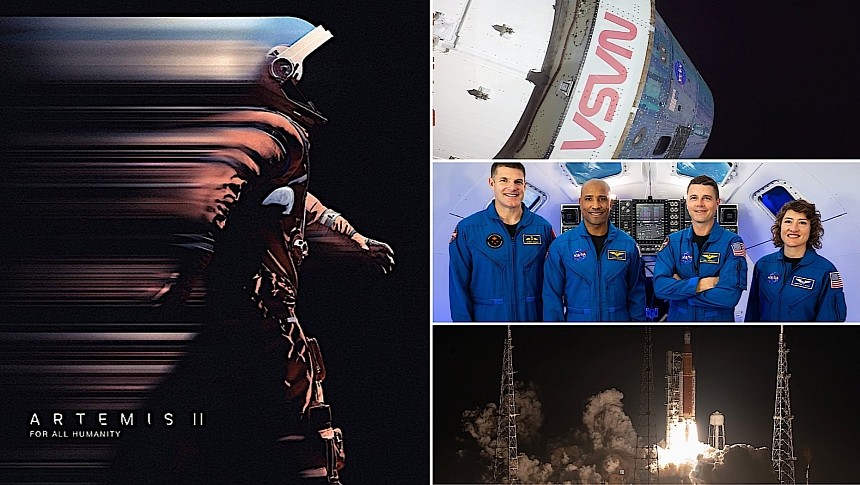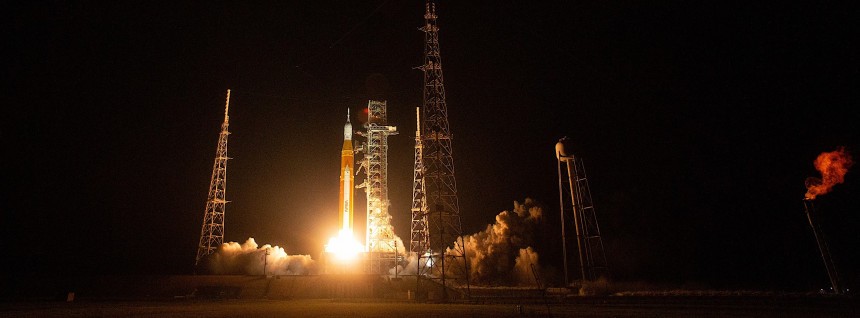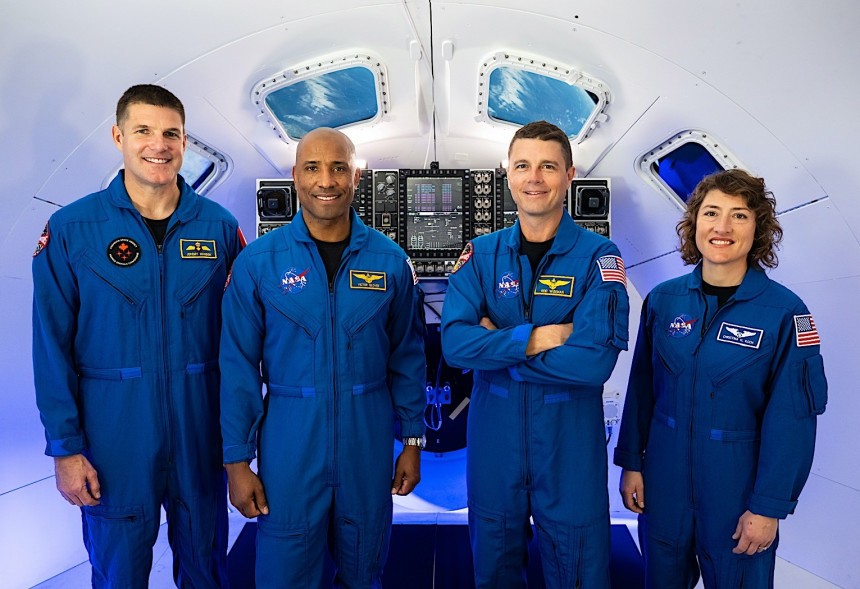If all goes according to plan, in November 2024 the second mission of the Artemis Moon exploration program is set to depart. Unlike Artemis I, which was uncrewed, this one will have people on board. Sure, it will not land them anywhere on the lunar surface, but it will break records in terms of distance covered by humans. And, despite the mission still being a long time out, we know enough about it to get a pretty good picture of how it'll all go down.
At the end of last year, following a few failed attempts, NASA managed to launch for the first time the Space Launch System (SLS) rocket and the Orion capsule. It was a very long, 25-day test drive, if you will, of the technologies that would keep future Artemis crews safe in space, and return them in one piece back to Earth.
UPDATE January 2024: The launch of Artemis II mission was pushed to September 2025.
Neither the SLS and the Orion used for Artemis I are reusable in full, meaning the second mission of humanity's second space exploration program will not use the exact same hardware. The design and specs, however, are pretty much the same, with the SLS Block I serving as the main launch hardware for Artemis II and III as well.
As a reminder, we're talking about the most powerful rocket ever flown on an actual space mission, capable of developing 8.8 million pounds of thrust, 15 percent more than the Saturn V of the Apollo program.
On top of the SLS will sit the Orion spaceship, a capsule developed jointly by Lockheed Martin. Airbus contributed the European Service Module that supplies the astronauts with electricity, water, and oxygen, and holds the main engine of the spaceship and some fuel.
Unlike what happened with Artemis I, the second mission will see all four seats of the Orion occupied by the most diverse crew that ever flew all the way to the Moon.
The commander of the mission is American astronaut Reid Wiseman. He's mostly known for being part of a 165-day mission to the International Space Station (ISS) as part of Expedition 41. During his trip up there, Wiseman and his team set a record for research, spending 82 hours on various projects during a single week.
Second-in-command and the mission's pilot is American Victor Glover. He will become the first person of color to make a trip so far out into space. To date, he's best known for being on board the first crewed mission of the SpaceX Crew Dragon back in 2020. He served as a flight engineer during Expedition 64 which the Crew Dragon transported to the space station.
The first female to be sent to the Moon is Christina Hammock Koch. She's also one of the most experienced people in the Artemis II crew, having served as flight engineer on the ISS three times, during Expeditions 59, 60 and 61. She also set a record for the longest single spaceflight by a woman (328 days), and was part of the first-ever all-female spacewalk in 2019. On Artemis II, she will serve as mission specialist.
The same role was assigned to Jeremy Hansen. Although new to space, the astronaut made a name for himself by being part of the seven-day NEEMO 19 mission to the ocean floor back in 2019. He's also the first Canadian to lead a NASA astronaut class, and he'll become the first Canadian to reach the Moon.
These four people will climb inside the Orion next year, and launch from the historically-important Launch Complex 39B at NASA's Kennedy Space Center in Florida. The mission is planned to last up to ten days, divided into segments.
For the first two days, the Orion and its crew will orbit our planet in relatively close proximity. During this time, the spaceship's systems will be put through their paces and, separately, a lunar targeting demonstration will be performed.
When and if everything checks out, the ship will set course for the Moon and head that way. The trip out is estimated to take four days, taking the crew to a distance from Earth of about 230,000 miles (370,000 km). The farthest point the spaceship will reach is 6,400 miles (10,300 km) beyond the Moon, which is also the farthest any human has ever traveled. For the duration of the mission, all imaginable tests will be conducted on the vehicle's systems.
The trajectory chosen for the mission is in the shape of figure eight. This approach was selected because, on the return trip, which is also expected to last four days, the Orion will use no means of propulsion, but only the Earth-Moon gravity field. In essence, the craft will be pulled back home by Earth itself.
Once home, the Orion will perform an atmospheric re-entry, which will end in a splashdown off the coast of San Diego, in the Pacific Ocean. The crew will be recovered from there in the usual fashion.
If successful, the Artemis II mission will open the doors to the flight that'll actually land people on the Moon once more. Artemis III is scheduled to leave Earth around 2025.
UPDATE January 2024: The launch of Artemis II mission was pushed to September 2025.
Neither the SLS and the Orion used for Artemis I are reusable in full, meaning the second mission of humanity's second space exploration program will not use the exact same hardware. The design and specs, however, are pretty much the same, with the SLS Block I serving as the main launch hardware for Artemis II and III as well.
As a reminder, we're talking about the most powerful rocket ever flown on an actual space mission, capable of developing 8.8 million pounds of thrust, 15 percent more than the Saturn V of the Apollo program.
On top of the SLS will sit the Orion spaceship, a capsule developed jointly by Lockheed Martin. Airbus contributed the European Service Module that supplies the astronauts with electricity, water, and oxygen, and holds the main engine of the spaceship and some fuel.
Unlike what happened with Artemis I, the second mission will see all four seats of the Orion occupied by the most diverse crew that ever flew all the way to the Moon.
Second-in-command and the mission's pilot is American Victor Glover. He will become the first person of color to make a trip so far out into space. To date, he's best known for being on board the first crewed mission of the SpaceX Crew Dragon back in 2020. He served as a flight engineer during Expedition 64 which the Crew Dragon transported to the space station.
The first female to be sent to the Moon is Christina Hammock Koch. She's also one of the most experienced people in the Artemis II crew, having served as flight engineer on the ISS three times, during Expeditions 59, 60 and 61. She also set a record for the longest single spaceflight by a woman (328 days), and was part of the first-ever all-female spacewalk in 2019. On Artemis II, she will serve as mission specialist.
The same role was assigned to Jeremy Hansen. Although new to space, the astronaut made a name for himself by being part of the seven-day NEEMO 19 mission to the ocean floor back in 2019. He's also the first Canadian to lead a NASA astronaut class, and he'll become the first Canadian to reach the Moon.
For the first two days, the Orion and its crew will orbit our planet in relatively close proximity. During this time, the spaceship's systems will be put through their paces and, separately, a lunar targeting demonstration will be performed.
When and if everything checks out, the ship will set course for the Moon and head that way. The trip out is estimated to take four days, taking the crew to a distance from Earth of about 230,000 miles (370,000 km). The farthest point the spaceship will reach is 6,400 miles (10,300 km) beyond the Moon, which is also the farthest any human has ever traveled. For the duration of the mission, all imaginable tests will be conducted on the vehicle's systems.
The trajectory chosen for the mission is in the shape of figure eight. This approach was selected because, on the return trip, which is also expected to last four days, the Orion will use no means of propulsion, but only the Earth-Moon gravity field. In essence, the craft will be pulled back home by Earth itself.
Once home, the Orion will perform an atmospheric re-entry, which will end in a splashdown off the coast of San Diego, in the Pacific Ocean. The crew will be recovered from there in the usual fashion.
If successful, the Artemis II mission will open the doors to the flight that'll actually land people on the Moon once more. Artemis III is scheduled to leave Earth around 2025.











